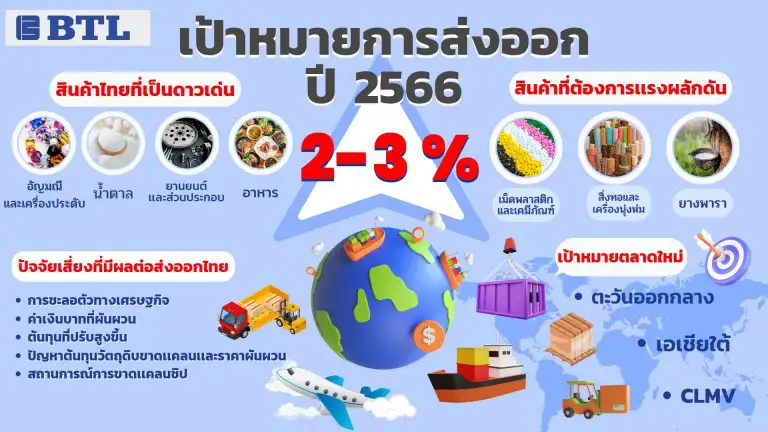Thailand Expands into New Markets as 2023 Export Growth Slows
January, 12 2023

Thailand’s export slowdown has become more evident, particularly after consecutive declines in export value in October and November 2022, raising concerns among stakeholders. Given the clear signs of deceleration, strategic measures are required to sustain exports, which are a key factor in the country’s economic recovery.
Chaiyacharn Charoensook, Chairman of the Thai National Shippers’ Council (TNSC), stated that Thailand’s export growth for 2023 is forecasted at 2-3%, based on the lack of significant increase in export volume in 2022. The number of shipping containers used in 2022 was similar to 2021, with rising export values largely due to higher costs of raw materials and oil, as well as the depreciation of the Thai baht relative to competitor currencies.
In 2023, oil prices are expected to decline to $75-85 per barrel, while the Thai baht is projected to appreciate to 33-35 baht per US dollar, which could put pressure on export prices.
Key Economic Factors Affecting Global Trade in 2023
- Slowing global economy – Global trade is expected to grow at a lower rate of 2.6-2.7%.
- Inflationary pressures – Central banks are likely to maintain tight monetary policies despite some easing in 2023.
- Baht appreciation – The rapid strengthening of the Thai baht compared to competitors may impact exporters' price competitiveness.
- Rising business costs – Higher costs in Thailand, including electricity (FT) and wages, make exports less competitive than other countries.
- Raw material shortages and price fluctuations – The Russia-Ukraine war continues to impact global supply chains.
- Semiconductor shortage – The situation started improving in Q3 and Q4 of 2022, which benefits the automotive and electronics industries.
Opportunities and Challenges for Thai Exports in 2023
Sectors with strong export potential:
- Food products
- Sugar
- Gems and jewelry
- Automobiles and auto parts
Sectors facing challenges:
- Rubber – China’s Zero-COVID policy and lockdowns have impacted tire production and demand.
- Plastics and chemicals – China’s Dual Circulation policy emphasizes domestic manufacturing, reducing dependence on imports. Additionally, China has developed its own large-scale chemical production facilities, increasing competition for Thai exports.
- Textiles and garments – Demand declined in Q4 2022, and is expected to remain weak in early 2023 due to slowing economies in major markets like the US and the EU.
Despite challenges, opportunities remain in secondary markets that are recovering from COVID-19, such as the Middle East.
Strategy for Thai Exports: Expanding into New Markets
Thailand aims to open new markets while maintaining existing ones, targeting emerging economies in South Asia, the Middle East, and ASEAN’s CLMV countries.
Three key target markets:
- Middle East: Saudi Arabia, UAE, Qatar – Targeted 20% export growth, from $8.9 billion in 2022 to $10.3 billion in 2023. Key exports include food, auto parts, air conditioners, and construction materials.
- South Asia: India, Bangladesh, Nepal – Targeted 10% export growth, from $12 billion in 2022 to $13.2 billion in 2023. Key exports include chemicals, plastics, automobiles, and auto parts.
- CLMV (Cambodia, Laos, Myanmar, Vietnam): Targeted 10-15% export growth, from $28 billion in 2022 to $33.5 billion in 2023. Key exports include construction materials, electrical appliances, plastics, and textiles.
Conclusion: “2 Increase, 2 Reduce” Strategy
To remain competitive in 2023, Thai exporters must focus on:
- Increasing market expansion and financial liquidity
- Reducing production costs and inventory levels
Jurim Laksanawisit, Deputy Prime Minister and Minister of Commerce, emphasized that Thailand will aggressively penetrate high-potential markets beyond regular trade measures to sustain and boost exports in 2023.